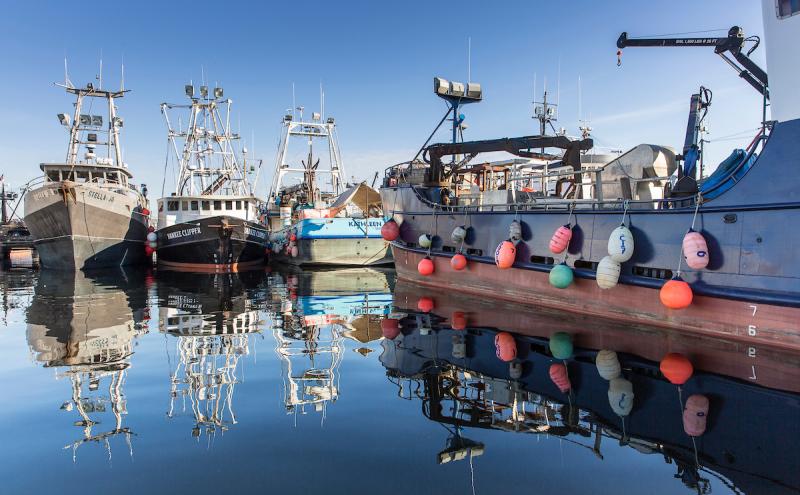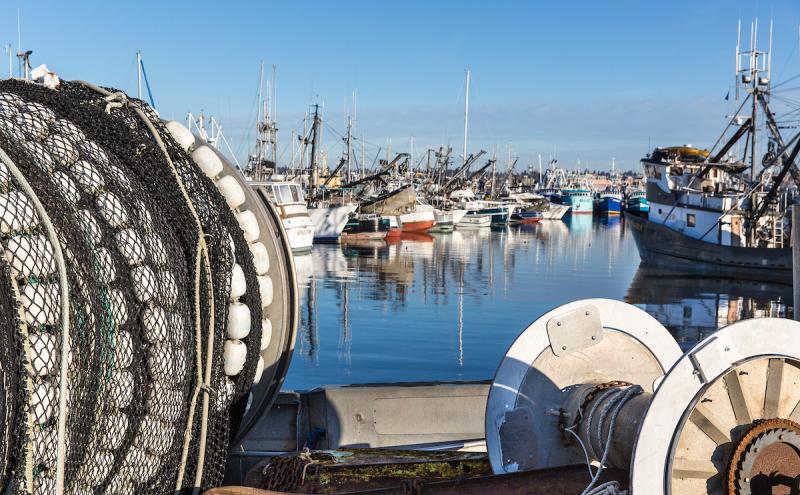
Based upon a presentation at the April 28 Port commission meeting with Stephen P. Metruck and Andy Wink, Executive Director of the Bristol Bay Regional Seafood Development Association.
• Read the commission memo
• Read the presentation
Our city, our region, and our Port were built on the foundation of commercial fishing. Fishermen’s Terminal opened for business in 1914 and has since established Seattle as the home port of the North Pacific Fishing Fleet. Since 1976, Terminal 91 has been the home port to the trawl catcher processor fleet. Both home ported fishing fleets have provided sustainable economic contributions to the citizens of King County and feed the country and the world with wild harvested seafood.
Commercial fishing is defined as an essential business by the states of Washington and Alaska, but the fleets are faced with the reality of the COVID-19 pandemic and the need to keep fishers and residents of fishing areas safe.
Economic impact of commercial fishing
Let’s first consider how commercial fishing feeds the world and the economies of the Pacific Northwest and state of Alaska:
- More than 11,000 jobs representing more than half a billion dollars in payroll depend upon vessels that moor at Port of Seattle
- $1.4 billion in business output for those vessels
- 44% of all gross earnings from the North Pacific Fisheries is earned by vessels moored at Port facilities
- 72% of the biomass harvested by those boats is exported throughout the world
- Seafood is regularly among The Northwest Seaport Alliance’s top five exports by dollar value
- Our region supplies 13% of the total US commercial fisheries harvest by value
COVID-19 challenges
As in other industries, the COVID-19 national health crisis has placed the commercial fishing industry in unprecedented times. This otherwise sustainable industry is subjected to the standards and protocols of maintaining safe working conditions for its most valuable resource, the employees. The global pandemic has presented challenges to the industry and its crews who often work in close quarters on fishing boats.
Because of state and national social distancing mandates, the large boat catcher processing companies and the independent fishers alike will have to certify its employees are virus-free and will be subjected to additional safety measures like testing and quarantining crew members. Some coastal towns in Alaska, including tribal communities, have lobbied the State of Alaska to cancel this year’s salmon season and close prime salmon fishing grounds.
Protective actions by State of Alaska
To slow the spread of COVID-19 and protect the public health of Alaskans, the state of Alaska issued Health Mandate 017: Protective Measures for Independent Commercial Fishing Vessels effective April 24.
The following compliance measures must be taken by vessels in the state of Alaska:
- If vessels or crew members travel between Alaskan communities, or travel to enter Alaska and begin work before a self-quarantine period is complete, they must submit a community workforce protective plan to the Department of Homeland Security’s Unified Command
- The plan must outline protective measures the vessel will enact in order to avoid the spread of COVID-19 and not endanger lives in the communities in which they operate
- Fishers must check with the Harbor Master prior to arrival at each port of call to ensure compliance
- If workers are able to complete a full 14-day self-quarantine before starting work, that is the preferred method. If not, they must adhere to the protective measures in the plan during work time. And follow guidelines for self-quarantine during non-work periods
- If transiting from the Lower 48 to Alaska via boat, transit time can be counted toward quarantine time
For additional compliance information, check:
• Commercial Fisheries Entry Commission (CFEC)
• Alaska Division of Homeland Security and Emergency Management (DHS&EM)
Compliance protocols
In response, commercial fishing industry associations have designed compliance protocols to respond to the health crisis and provide state-mandated health safety compliance to crew members who work on catcher boats and deliver their harvested fish to processing plants in coastal communities in Bristol Bay and Southeast Alaska.
Here’s how the fishing industry is working to comply with Federal and State social distancing mandates to protect crew members and populations of coastal community populations in Alaska for the two primary fleets at the Port of Seattle:
Large boats at Terminal 91
Typically owned by corporations, this fleet harvests and process pollock, pollock roe, hake, yellow-fin sole, and other flat fish. The fishing seasons for these boats at Terminal 91 are:
- Mid-January through mid-April: Pollock A
- Mid-May through late June: Hake
- June-October: Pollock B
- August-October: Pollock C and D
- September-November: Hake
This fleet is taking the following protective actions:
- At least one company is working with CTA to use Smith Cove Cruise Terminal for testing
- Conducting health screenings before crew members board boats
- Collaboration between fishing companies, associations and shoreside processors through the Alaska Fishing Industry Safety and Health Committee (AFISH) and the Washington State Department of Commerce to ensure the safety of their workforce at-sea and ashore. The purpose of AFISH is to bring together fishing and fish processing companies, medical advisors, and public health partners for the common goal of protecting the health and welfare of fishers and seafood workers from emerging infectious disease threats
Smaller boats at Fishermen’s Terminal
The gillnetters, purse seiners, and halibut schooners are typically owned by individuals or small companies. And they harvest salmon, halibut, black cod, and other species. The fishing seasons for small boats based at Fishermen’s Terminal are:
- Mid-April through September: salmon
- October through April: Winter king season for trollers
And they are taking protective measures including:
- Following social distancing guidelines
- Limiting vessel access
- Keeping critical crew aboard the boat
- Working to meet Alaska guidelines
- Collaborating with fishing associations to get updated information
- Submitting a community workforce protective plan to the Department of Homeland Security’s Unified Command
- Documenting protective measures to protect the communities in which they operate from COVID-19 if vessels or crew members travel to or within Alaska before their self-quarantine period is complete
Port of Seattle assistance
Open facilities
The Port is keeping fishing facilities, including Fishermen’s Terminal and Terminal 91 open so fishers can prepare for the spring and summer commercial fishing seasons:
- The small boat fleet will begin mending salmon sein and gill nets at Fishermen’s Terminal for the summer salmon fishery in Alaska
- And larger trawl vessels will begin crewing up for the Hake fishery off the coast of Washington in late spring
Deferred moorage relief
Because salmon and hake seasons have not yet started, it is difficult to predict how economic factors will influence the price of wild seafood. Vessel owners are eligible for deferred moorage relief programs from the Port of Seattle. For vessel moorage customers with demonstrated impact and need, the Port will defer moorage payments and other fees for three months — April, May, and June of 2020. The Port will work with customers to develop repayment plans.
Federal government assistance
Salmon harvesters are eligible for Federal stimulus programs operated by the US Small Business Association (SBA) such as the SBA Paycheck Protection Program, SBA Economic Injury Disaster Loan and Emergency Advance, SBA Express Bridge Loans, SBA Debt Relief
Support from two programs as well as two programs created by the CARES Act, the Pandemic Unemployment Assistance, and Section 12005 Seafood Industry Assistance. This program includes $300 million in funds specifically set aside for commercial fishers.









